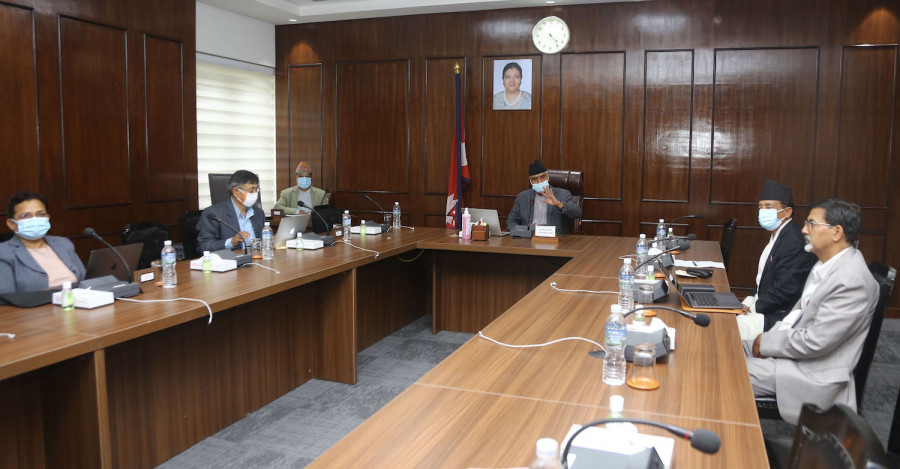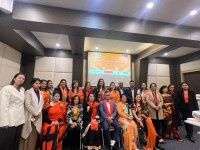National
Pandemic rages on but money in Covid-19 fund remains unspent for past six months
Not a single rupee has been released from the Coronavirus Prevention, Control and Treatment Fund since January 27.
Prithvi Man Shrestha
The fund created by the government to generate resources to fight Covid-19 through voluntary contributions has remained idle throughout the second wave of the pandemic, with no budget released since January 27.
The Coronavirus Prevention, Control and Treatment Fund was set up in March 2020, two months after the country reported its first infection, with a view to using the money for procuring medicines and medical goods, setting up infrastructure for the management of the infected, mobilising human resources and providing relief for those hit hard by the pandemic.
The government had established the fund by issuing the ‘Directives on Coronavirus Prevention, Control and Treatment Fund-2020’.
When the pandemic caused a humanitarian crisis in May, the government decided to bring the fund, headed by the National Planning Commission vice-chairperson, under the reorganised Covid-19 Crisis Management Centre (CCMC), through an ordinance.
Even after coming under the new structure, not a single rupee has been released from the fund for procuring medical goods and building health infrastructure, according to official records.
As per the Financial Comptroller General Office, which keeps the record of the government’s income and expenditures, after Rs85 million was released from the fund on January 27, no money has been released until mid-July, the end of the last fiscal year.
“As there is no working procedure ready to release the budget from the fund after it came under the CCMC, the fund has remained idle so far,” said Nurahari Khatiwada, spokesperson for the CCMC. “A draft of the working procedure is under discussion at the Prime Minister’s Office. Once the Cabinet approves it, we will be able to spend from the fund.”
Before January 27, four other meetings of the fund’s board chaired by the National Planning Commission vice-chairperson had released money for various purposes including developing health infrastructure like freezers required to manage bodies, setting up oxygen plants and oxygen management systems, hospital beds, intensive care units (ICUs) and laboratories, and procuring ventilators and polymerase chain reaction (PCR) machines.
In the last fiscal year, a total of Rs1.48 billion was released from the fund, all before the second wave hit the country in early-April. There is still Rs452.55 million remaining in the fund.
Current and former officials said a relatively small amount of money remaining in the fund and the Finance Ministry itself arranging funds for the procurement of medical supplies and infrastructure were primary factors behind its non-use during the second wave of the pandemic.
“The size of the fund could not grow much and the Finance Ministry was also providing resources from other sources,” said Maheshwor Neupane, secretary at the Prime Minister’s Office, who also participated in the meeting of fund’s board as secretary of the Home Ministry before his recent transfer to the Prime Minister’s Office.
But, a secretary on condition of anonymity said the political crisis created after the House of Representatives was dissolved twice might have also disoriented the government from the fund.
President Bidya Devi Bhandari had dissolved the lower house on December 22 last year and May 21 as per the recommendation of the then prime minister KP Sharma Oli, but the Supreme Court reinstated the House both times terming the moves constitutional.
Before the House was dissolved the second time, Oli sought a vote of confidence in the House of Representatives but failed the floor test on May 10. As a result, the office-bearers of the National Planning Commission also lost their positions as per the commission’s Formation and Operating Order-2018. After he was appointed prime minister on May 13, once again as leader of the largest party on May 13, the same office bearers at the commission were reappointed on May 20.
Officials at the Prime Minister’s Office say the absence of the vice-chair in the planning body for some time also contributed to delay in the meeting of the fund’s board.
Former vice-chairperson of the planning body Pushpa Raj Kadel had told the Post in early June that the fund had received no request for resources allocation from any government entities and no meeting was held for a prolonged period.
He had also claimed that a meeting of the fund’s board in late May before its formal handover to the CCMC, had decided to distribute funds between Rs500,000 and Rs1 million to each district for the management of the bodies of Covid-19 victims.
But, there is no record of any fund distribution until mid-July [end of last fiscal year] at the Financial Comptroller General Office.
But, health experts say that failure to utilise the fund, which was created to tackle the pandemic, even in times of huge public suffering suggests how indifferent the political leadership became towards people’s woes during the second wave of the pandemic.
The country’s health system was pushed to the brink when hospitals started turning away Covid-19 patients due to the lack of oxygen and beds. The second wave of the pandemic has seen two and a half times more deaths and several times higher numbers of infections compared to the first wave, which saw around 3,000 deaths.
As of Friday, the total death toll from Covid-19 has reached 10,455 and total infections are at 744,307, according to the Ministry of Health and Population.
“Even with the limited resources of the fund, works like contract tracing, logistic management at hospitals and providing support to the poor could be done,” said Dr Basudev Pandey, former director at the Epidemiology and Disease Control Division under the Health Ministry. “But, the country’s politics took primacy over the pandemic and affected the whole efforts against the disease.”
Besides releasing no budget since January, the leadership of the fund also made no efforts to increase the size of the fund over the last several months.
According to the directives on Coronavirus Prevention, Control and Treatment Fund-2020, key resources of the fund include receipts from the federal government, provincial governments and local governments; foreign governments, institutions/organisations or individuals; governmental and non-governmental organisations; and domestic organisations or individuals.
When the fund was created last year, ministers, lawmakers, private companies, police personnel, non-governmental organisations and individuals had contributed to it.
According to the Financial Comptroller General Office, only Rs585.50 million was collected in the fund in the last fiscal year 2020-21, a sharp drop from Rs1.35 billion in the previous fiscal year.



 7.12°C Kathmandu
7.12°C Kathmandu















